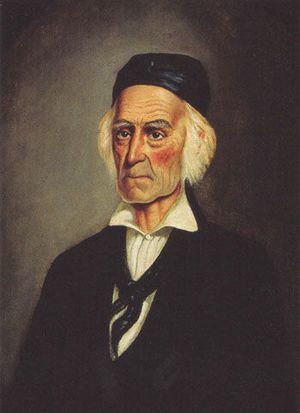Lugo family of California facts for kids
The Lugo family was a very important family in California during the times when Spain and Mexico ruled the land. They were among the first settlers who were called Californios. These families played a big role in shaping early California.
Contents
Francisco Salvador Lugo: An Early Settler
Francisco Salvador Lugo (1740–1805) was born in Sinaloa, Mexico. He came to California in 1774 as a soldier. He served in northern California until 1781. Then, he helped establish the Pueblo de Los Angeles. Francisco Lugo was one of the soldiers who guided the first farming families and settlers to Los Angeles in 1781. His name is on a special plaque that honors those who founded Los Angeles on September 4, 1781.
Francisco Lugo married Juana María Martínez y Vianazul. They had nine children together.
Antonio Maria Lugo: A Leader in Early Los Angeles
Antonio Maria Lugo (1778–1860) was born at Mission San Antonio de Padua in what is now Jolon, California. He was the seventh son of Francisco Salvador Lugo. After serving as a soldier for 17 years, he left the army in 1810. He then settled with his family in the Pueblo de Los Angeles.
In 1810, Antonio Lugo received a large piece of land called Rancho San Antonio from the Spanish government. This grant was later confirmed by the Mexican governor in 1838. In 1816, he even served as the alcalde (which means mayor) of Los Angeles. In 1841, he received another land grant, Rancho Santa Ana del Chino. On his Rancho San Antonio, he built Casa de Rancho San Antonio, which is the oldest home in Los Angeles County, California.
Antonio and his wife, Maria de Los Dolores Dominguez Lugo, had five sons and three daughters. One of their daughters, Maria, married Stephen Clark Foster, who became the first American mayor of Los Angeles after the Mexican–American War.
José del Carmen Lugo: A Major Landowner
José del Carmen Lugo (1813 – around 1870) was a very important landowner in Southern California during the 1800s. He was born in 1813 in the Pueblo de Los Angeles. At that time, California was a Spanish colony. José del Carmen Lugo was the oldest son of Antonio Maria Lugo.
Expanding the Family's Land Holdings
José del Carmen Lugo worked with his brothers, José María and Vicente Lugo, and his cousin, Diego Sepúlveda. They started settling the San Bernardino Valley and the nearby Yucaipa Valley. This land covered more than 250,000 acres (about 1,000 square kilometers). The Mexican government approved their plan to settle the area in 1839.
The valley faced challenges from robberies and raids by California Indians who were trying to protect their homelands. Many settlers did not stay long. However, the Lugo families became strong friends with the Mountain Band of Cahuilla Indians, led by Chief Juan Antonio.
In 1842, the Lugo family bought the San Bernardino Asistencia. This was a former "sub-mission" of Mission San Gabriel. The old adobe buildings were in poor condition. Lugo made repairs and soon moved into the asistencia with his wife and two daughters.
To protect their land, the Lugo family applied for and received the Rancho San Bernardino Mexican land grant in 1842. This grant covered 35,509 acres (about 144 square kilometers).
Role During the Mexican–American War
During the Mexican–American War, Lugo led a group of Californio soldiers. In December 1846, he was involved in conflicts with Native American groups. His forces, along with allied Cahuilla people, fought against a group of Luiseño Indians.
He was a leader of Californio forces during the Battle of Chino and the Temecula Massacre. By January 1847, he was put in charge of the prisoners from the Chino battle. Lugo took the prisoners to the Rancho Santa Ana del Chino and released them.
In March 1847, he met with the American John Charles Fremont in Los Angeles. Fremont asked Lugo to gather as many abandoned horses as possible. Lugo collected about 60 horses between Los Angeles and San Bernardino.
Life After the War
The United States won the Mexican–American War, and California became part of the U.S. in 1848. In May 1849, the U.S. military Governor, Richard Barnes Mason, appointed Lugo as the first Mexican-Californio mayor of Los Angeles after the U.S. took control.
In August 1849, he was elected Justice of the Peace for Los Angeles. He served in this role until January 1850.
In 1852, Lugo sold Rancho San Bernardino to Amasa M. Lyman and Charles C. Rich. These men were leaders of the Church of Jesus Christ of Latter-day Saints. José del Carmen Lugo's financial situation became difficult in later years. In 1854, he borrowed money and put up all his property, including his home in Los Angeles, as a guarantee. He eventually lost his house and land in Los Angeles because he could not pay back the loan.
José del Carmen Lugo passed away in 1870. He died without much money.
Felipe Lugo
Felipe Lugo was baptized on August 6, 1807, at Mission San Gabriel. He married Maria "Pancha" Perez, and they had many children, possibly as many as 16. He passed away on May 9, 1885, at Rancho San Antonio. He is buried at Old Calvary Cemetery in Los Angeles.
Rancho Potrero de Felipe Lugo is named after him.
Vicente Lugo
See also
- 19th century in Los Angeles
- History of San Bernardino, California
- Ranchos of Los Angeles County, California
- Ranchos of San Bernardino County, California
- Lugo Adobe (Don Vicente Lugo home)
 In Spanish: José del Carmen Lugo para niños
In Spanish: José del Carmen Lugo para niños


